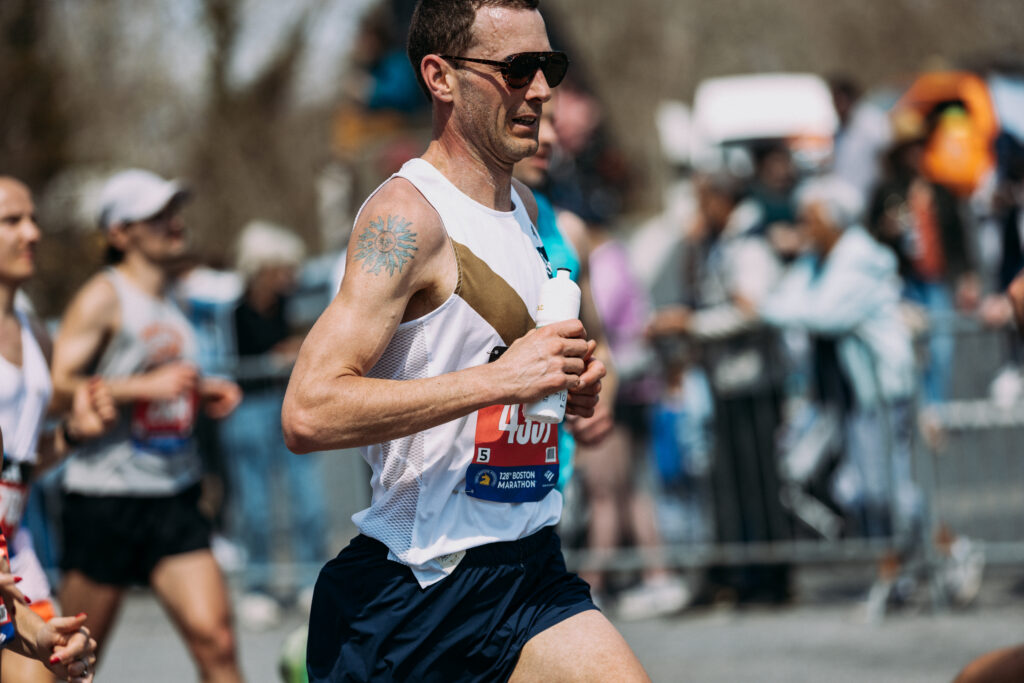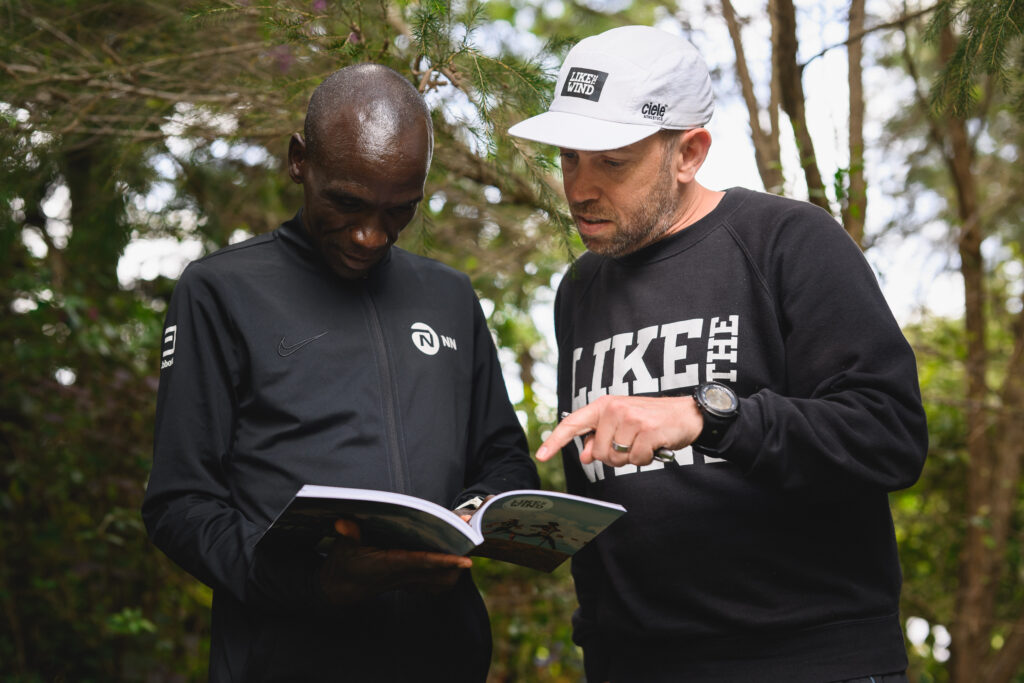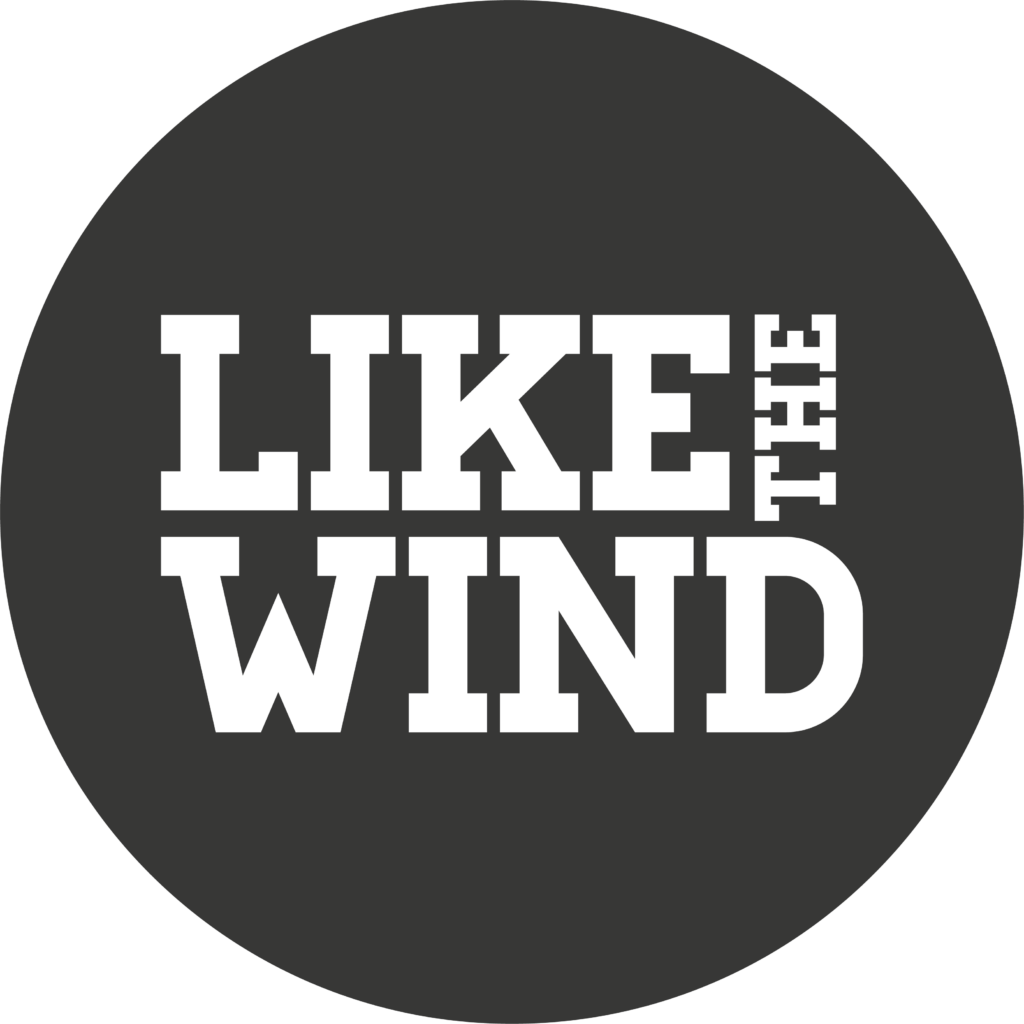The Golden Thread of Storytelling
LIKE THE WIND FOUNDER SIMON FREEMAN IN CONVERSATION WITH TRACKSMITH FOUNDER MATT TAYLOR
Photography by Chris Milliman (1) & NN Running Team (2)
A love of stories is at the core of both Tracksmith and Like the Wind magazine. Tracksmith founder and CEO Matt Taylor and Like the Wind publisher Simon Freeman sat down online to compare notes about the origins of their shared passion for storytelling and their common belief in its transformative power. Plus, they delve into some of their favorite running stories.
It’s Sunday. Simon is in Switzerland, where the day is almost over, while for Boston-based Matt it is morning, and he’s already got a full agenda. For both of them, Sunday is a running day: Simon is in recovery mode while Matt is contemplating how to balance the day’s family commitments with training.
Matt has been a runner for as long as he can remember, which he ascribes to finding something he was good at into which he then leaned. But it wasn’t until Matt went to Yale University that he really fell in love with running, when he was competing in varsity cross country and track. Simon’s start as a runner couldn’t be more different — he started late, just before turning 30 years old. Still, both Simon and Matt discovered a deep affinity for storytelling, albeit from different starting points.
Matt, a lifelong runner, and Simon, who didn’t start running until he was 30, share a deep affinity for storytelling, albeit from different starting points.
Matt was involved in storytelling early in life, launching a project that would inform much of what he has done at Tracksmith in the last decade. But before that, he went through a period of exploration, searching for his path. “Right out of college, I did a few normal professional career things,” Matt says. “Then, I had a failed startup early on.” After this somewhat-rocky start, Matt landed a role at sports-management giant IMG. Then he joined Puma as head of marketing, working with athletes like Usain Bolt when he was the fastest sprinter in the world. But the way big brands approached storytelling was very different to his natural inclination. “I literally would be on million-dollar photo shoots where somebody is running past one scene 10 times, with a crazy amount of people and lighting, to get one image that’s going to show up on billboards, in magazines and in the shops,” he says. “We were creating this one hero asset.”

Matt had the sense that the way the brand communicated was not what many runners wanted to see. And he had evidence of that from a personal project (the Chasing series) he had kicked off in 2005 straight after he graduated from college. “Basically, I spent 11 weeks at 11 of the best NCAA cross country programs in the US,” he says about the project. “I had a laptop and cameras and I lived with athletes on the team, shadowing them around for one week. Every day and evening, I would write a post about what happened that day. I would share photos. I would do these little, short video clips.”
This first iteration of the concept was called Chasing Tradition and it captured the 2005 athletics season. And whilst Matt maintains that he “was extremely average, maybe even below average” at the individual elements of writing, photography and film making, there was something in the combination that was special. “What was unique about Chasing Tradition was that none of this type of content existed at the time,” he says. “So for the niche audience that loved college cross country, they thought ‘holy shit, what is this?’ And so that audience was waiting every day for the next update, then next update, then next update.” It is worth remembering that Matt’s project pre-dated social media as we know it today. “People weren’t getting bite-sized clips every day, every hour,” he says. “They were waiting for the updates on the blog.”
The excitement that Chasing Tradition generated in the niche audience for whom it was intended was not the biggest surprise, however. It was the type of stories for which they clamored that was unexpected. “What was fascinating about that experience is that I went into it thinking that the audience was going to love hearing about the workouts,” Matt says.
But in Portland Matt created a behind-the-scenes video. “I showed the track house where everybody lived, and that same week, the athletes also did five-by-one-mile on grass, preparing for the first race of the season,” he says. “The engagement and views on the behind-the-scenes video about how the athletes were living got way more engagement than the workout one.”
Simon’s introduction to storytelling also came through marketing, but not in running. “I started my working life in media, selling advertising in a commercial real estate magazine,” he explains. “I certainly wasn’t a runner at that point. In fact, sport of any kind wasn’t consistently present in my life. But I was exposed to how one type of media company worked. After a few years of that, I landed a couple of jobs in corporate communications and marketing agencies, so I saw storytelling from a different angle. And then suddenly — literally overnight — running entered my life.”

At almost the same time that Matt was producing Chasing Tradition, Simon was discovering running and storytelling about running. “I took up running as a life raft,” Simon explains. “I was very unfit, unhappy and struggling with low self-esteem. Running felt like something I could do with very little investment or organization. I just decided to pull on a pair of sneakers — not even proper running shoes — and tried to run a lap of the block where I lived in central London.”
While Simon wasn’t immediately bitten by the running bug, he persisted. Soon, with some advice from friends who were runners, he found that it was helping him in many areas of his life. And that was worth documenting.
“In 2005, blogging was pretty new, and Instagram was five years out from being invented,” Simon recalls. “I wanted a way to keep myself accountable and also record this transformative activity. So, I set up a blog and I would write daily. Initially the posts were just a few thoughts about my day’s run, but soon I was interviewing other runners or reporting where I had run and the experiences I was having.”
The audience for Simon’s blog grew fast, and with the advent of Twitter and the Facebook news feed in 2006, his posts started getting traction — and those that explored Simon’s (and his guests’) reasons for running got the most engagement. “I found myself naturally drawn to the question of why people ran,” Simon says. “I had asked myself the same question when I started and I realized that this — the ‘why’ — was as unique to each runner as a fingerprint. It felt like the deepest possible well of stories.”
THE ART OF TELLING STORIES
Before founding Tracksmith, Matt was head of marketing, working with athletes like Usain Bolt when he was the fastest sprinter in the world. But the way big brands approached storytelling at the time was at odds with his natural inclination. “I literally would be on million-dollar photo shoots where somebody is running past one scene 10 times with a crazy amount of people and lighting to get one image that’s going to show up on billboards, in magazines and in the shops,” he says. “The goal was to create one hero asset.”
Matt had the sense that the way the brand communicated was not what many runners wanted to see. And he had evidence of that from a personal project called the Chasing… series, which he had kicked off in 2005 straight after graduating from college. “Basically, I spent 11 weeks at 11 of the best NCAA cross country programs in the US,” he says about the project. “I had a laptop and cameras and I lived with athletes on the team. I was extremely average at the individual elements of writing, photography and filmmaking, but what was unique about Chasing Tradition was that none of this type of content existed at the time. The niche audience that loved college cross country thought ‘Holy shit, what is this?’ I went into it thinking that the audience was going to love hearing about the workouts, but the behind-the-scenes video got way more engagement than the workout one.”
At almost the same time that Matt was producing Chasing Tradition, Simon took up running as a life raft. “In 2005, blogging was pretty new and Instagram was five years out from being invented,” Simon recalls. “I had just started running age 30 and I wanted a way to keep myself accountable and also record this transformative activity. So I set up a blog and I would write daily. Initially the posts were just a few thoughts about my day’s run, but soon I was interviewing other runners or reporting on where I had run and the experiences I was having.”
The audience for Simon’s blog grew fast, and with the advent of Twitter and the Facebook news feed in 2006, his posts started getting traction —and those that explored Simon’s (and his guests’) reasons for running got the most engagement. “I found myself naturally drawn to the question of why people ran,” says Simon. “I had asked myself the same question when I started and I realized that the ‘why’ was as unique to each runner as a fingerprint. It felt like the deepest possible well of stories.”
BUILDING BUSINESSES
For Simon, the launch of Like the Wind was a response to seeing long-form print magazines in other sports — cycling, surfing and adventure, for example — that explored culture, history and people. He co-founded the magazine with his wife Julie, with whom he had already launched a marketing agency. “We discussed the idea of creating the kind of running magazine we wanted to read,” Simon says. “Julie said, ‘How hard can it be?’ and we started with enthusiasm and optimism rather than skill. With the contacts I had through the blog, as well as a healthy dose of naivety, Like the Wind was born in 2014.” With a remit to do things differently from the existing mainstream media, the magazine printed stories to which Simon and Julie knew runners would relate.
“We all know what happens cognitively when your mind is allowed to go to different places” — MATT TAYLOR
Tracksmith launched at a time when the running apparel world was dominated by big brands who perhaps valued price and volume over quality and aesthetics. In that sense, it was a risk. But Matt has adopted a phrase his grandfather used when they played cards together: “God hates a coward.” The start of Tracksmith involved “five products and a print magazine,” according to Matt. And the magazine — called Meter — was integral at the beginning. “Not only as a product we were publishing and selling, but as part of how we brought the brand to life.”
In those early days of Tracksmith, the storytelling was all focused on what runners would recognize. “We went in saying, ‘Hey, let’s just take a group of athletes, have them do the hard training that they were planning to do, and we’re just going to be a fly on the wall and document all of that,’” Matt says. “What happens with that, is you get much richer storytelling because you’re seeing everything from them getting up at 6 a.m. to make coffee before the run to the post-run moments.” Matt even says that at the beginning, the team talked about not creating any imagery or films that showed people running — just the before and after. Because they knew that any runner will recognize those moments.
A SPECIAL MOMENT
If there is a single moment when the Tracksmith approach to storytelling came together perfectly, Matt says it was when the brand created an advertising campaign to be aired on television during the US Trials for the 2021 Tokyo Olympic Games. The campaign was called The Last Interval and it showed a group of athletes completing the last rep of the last workout before the biggest race of their lives. The film was shot by filmmaker Emily Maye with writer Malcolm Gladwell narrating the voiceover.
The last rep was, in fact, the footage that Tracksmith used. Both the male and female athletes finished their workouts and were completely spent. There was no artifice and no opportunity for another take. “The tenth [rep] of the men’s workout was by far the best,” Matt says. “It had the most drama. The best ending. And the women’s was the same. To me that was just the perfect storm of everything we love about our process coming together. It is still a highlight because it had such a big [television] audience and to have someone like Gladwell be involved, with his recognizable voice, added a nice dimension to it.”
“The ‘why’ we run is as unique to each runner as a fingerprint. It felt like the deepest possible well of stories” — SIMON FREEMAN
At Like the Wind, one of Simon’s highlights was when he sent a cold email to one of his heroes — Dick Beardsley — asking for a story to appear in the first edition of Like the Wind. “Beardsley quickly replied with a very unexpected tale of why he started running, which — spoiler alert! — involved the quest for a varsity jacket which he believed would get him a date with a girl,” Simon says. That story remains one of Simon’s favorites from the hundreds that have been published in 44 editions of the magazine so far.
As Simon and Matt wrap up their conversation, they return to how storytelling is ingrained in Tracksmith and Like the Wind. Matt is unequivocal: “If you’ve followed Tracksmith for a decade, I think it’s pretty clear how we have continued to storytell as a brand today.” And while Matt acknowledges that there are more channels than ever for storytelling, some things remain unchanged. “I still think that at the end of the day, great stories win, regardless of the format or distribution platform.”
Simon could not agree more. At the core of Like the Wind is a printed magazine. That will always be the case, because print is a medium that lends itself to the sorts of stories the magazine was created to tell. But that is not to say that ink-on-paper is the only format that Like the Wind will use. “Great stories can exist in myriad formats,” Simon says. “It could be a single image, a film, a book or in person at an event. At the end of the day, the story is the most important element. Get that right and then the right choice of media will add to it.”

